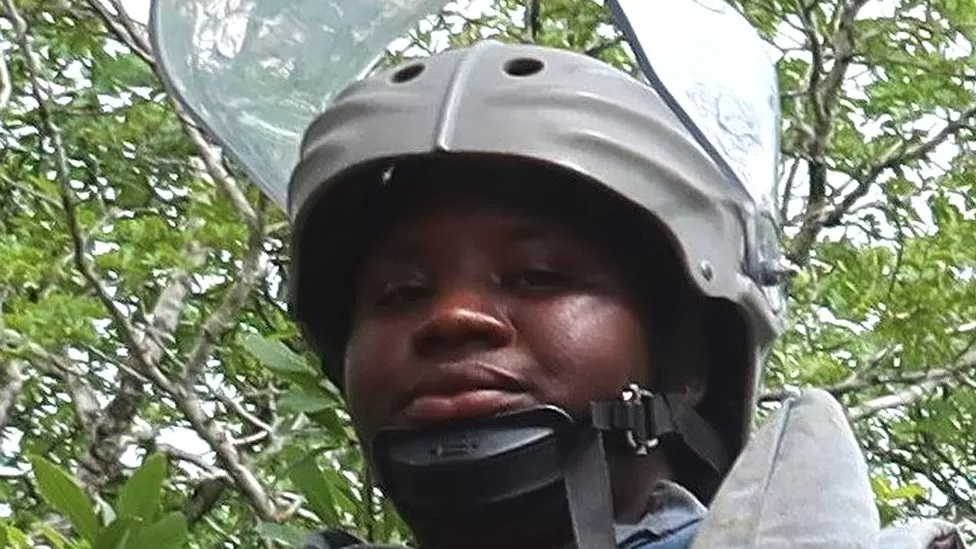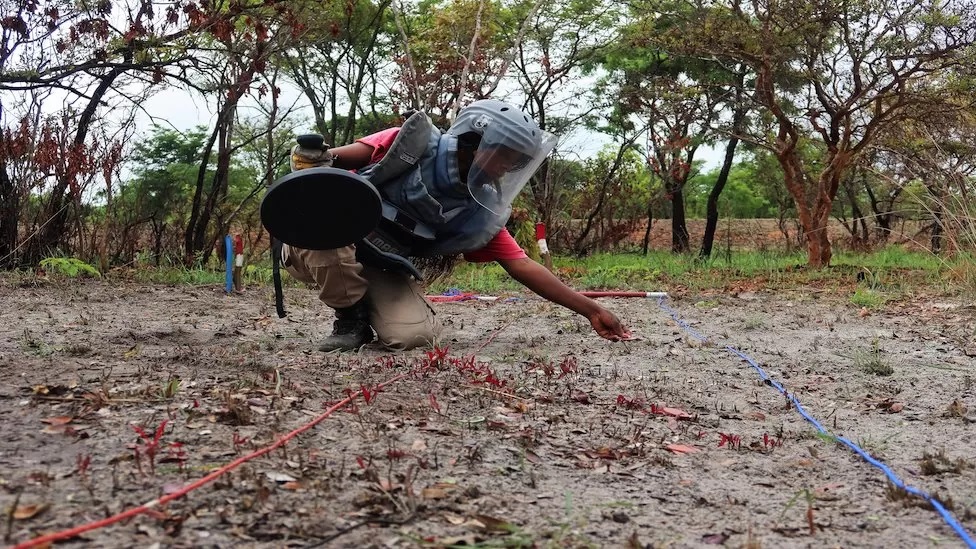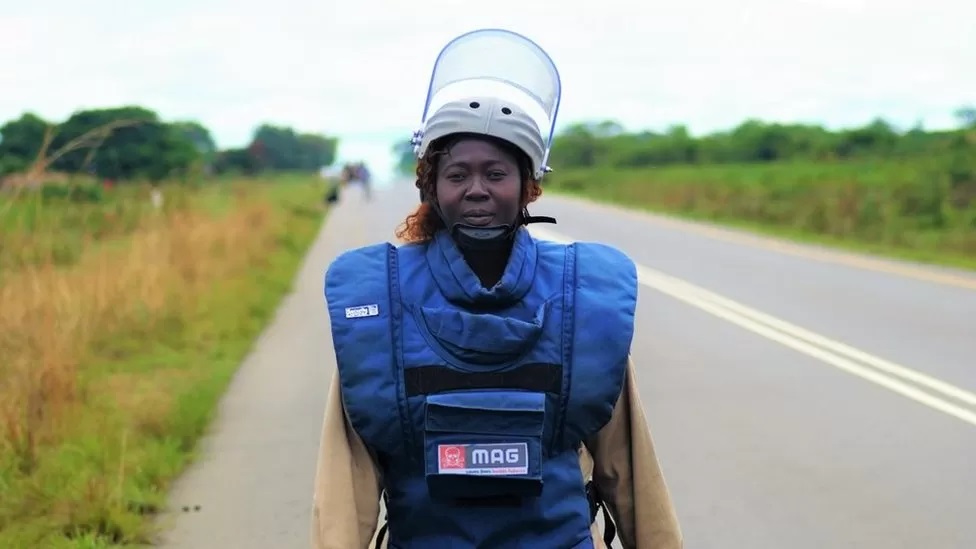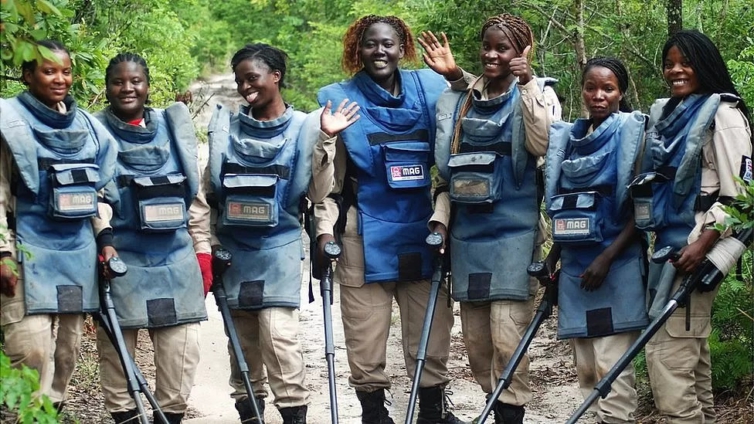An increasing number of women in Angola are working to get rid of the scourge of landmines left from the 27-year civil war, which are still claiming victims long after the fighting finished.
****
"I don't want my daughter, or any other child, to be the next victim of a landmine," Helena Kasongo tells the BBC on a video call from Moxico in eastern Angola.
Her smile broadens when she talks about her three-year-old daughter, despite the grim nature of the subject.
The child is still too young to really get what the 25-year-old mother does for a job, namely risking her life every single day at the "office".
Ms Kasongo, nonetheless, is adamant that the little girl will someday understand what led her mum to become a "sapadora" - the Angolan term for people who clear mines.
People are still dying or being maimed after coming across one of the millions of landmines or unexploded ordnance left over from the fighting that ended more than two decades ago.

The only national survey into this issue, carried out by the Angolan government in 2014, found that around 88,000 people were living with injuries caused by landmines in the country.
Organisations like the International Campaign to Ban Landmines say that the true toll may be higher still, as there is no on-going official monitoring of casualties.
Children are often the victims.
Three months ago, a six-year-old girl was killed, and six others were injured, in an explosion in Moxico province. According to local media, the children were playing with an unexploded bomb they found in a field, unaware of the risks.
"This is a story we all know too well. There is nobody in Angola who doesn't know someone who got injured. We need to stop this cycle for the good of our people and our nation," Ms Kasongo adds.
She works for the Mines Advisory Group (Mag), an NGO that since 1989 has overseen the destruction of landmines and assorted unexploded ordnance in 70 countries including Angola, where it estimates that an area of 7,300 hectares, equivalent to over 10,000 football pitches, still needs to be cleared.
This not only poses a risk to life, but also limits basic activities in the affected areas, including agriculture and construction.
This hurts the economy in already struggling places - more than half of Angolans live below the World Bank's international poverty line (earning the equivalent of less than $2 a day), despite a booming oil industry.
"Landmines cost lives and limbs, but they also hamper development and prevent displaced people from returning to their homes after conflict," Mag CEO Darren Cormack said in a statement.
"They trap communities not just in fear, but also in poverty."
Women can sometimes be worst affected by poverty, which also helps to explain why more women like Ms Kasongo are becoming "sapadoras".
The job offers good wages - ranging from $440 (£355) to $600 a month - and there is steady work, given the amount of land still to be cleared.
Women already make up almost 40% of Mag's mine-clearing personnel in Angola and there are more than 100 women working in this area for the Halo Trust, another demining organisation operating in the country.
"Humanitarian mine action has traditionally been a male-dominated sector, in part because of the specialist explosive ordnance disposal and military backgrounds of many staff," Mr Cormack explains.
"We proactively seek to recruit and train female deminers in all of our programmes as part of a long-term and developing strategy to address gender imbalance."

Ms Kasongo and her colleagues spend an average of six hours a day, six days a week, combing areas for landmines or explosives - they are at the forefront of attempts to rid Angola of the scourge.
They are equipped with heavy protective gear and using a metal detector methodically sweep a patch of land to find the hidden dangers. Once the locations are mapped, bomb experts come in to defuse the explosives.
The women are also challenging gender stereotypes and facing down peer pressure.
"My mum and my brothers did not want me to become a sapadora at all. They said it wasn't something a woman should be doing," says Joaquina Barbosa, 27, who also works for Mag.
"But I had been unemployed for five years and I wanted to work doing something that fulfilled me. Luckily, I didn't have a partner to try and stop me. [In the future,] any man will have to put up with me doing a dangerous job," she adds, with a loud laugh.

Brave as they are, the sapadoras are not immune from fear. Ngoie Graca Mulunda, 35, who has been doing the job for almost five years, admits that she is constantly aware of the danger.
"I still only relax after I put down my equipment. Fear is a constant companion, but it's also what makes you pay attention to avoid mistakes," she says.
"In this line of work, your first mistake could be your last."
Accidents are rare but not unheard of. According to Mag, there have been only two injuries and no deaths of deminers since 2012, when comprehensive records began to be collected.
But Angola still has a long way to go to rid itself of mines.
The country has been a member of the Anti-Personnel Mine Convention since 1997 - the year when Princess Diana made a famous visit to the country to raise awareness around the issue of landmines.
Under the terms of the treaty, the Angolan government is obliged to commit to total clearance, but the original December 2013 deadline has since been extended and is currently set for 2028.
One of the reasons for the delay, Mag says, is a shortage of donor funding, which is the source of the vast majority of financing for demining activities around the world.
The global scale of the problem is immense: at least 5,544 people were killed or injured by mines around the world in 2021, according to the International Campaign to Ban Landmines. Most of the victims were civilians, half of whom were children.
The sapadoras, however, are already dreaming of lending their expertise further afield once their job at home is wrapped up.
"I would really like to help other countries get rid of their landmines and prevent more people suffering injuries or dying," Ms Kasongo says.
"Only people who live in a place where danger is next door can really understand this feeling."
Latest Stories
-
We’ll establish fiscal council to rein in excessive borrowing – Finance Minister
10 seconds -
Mortuary workers issue fresh strike threat
4 mins -
‘Lapses in banking system are not unique’ – John Awuah on managing fraud in Ghana’s Banks
12 mins -
Bawumia confident of victory in 2024 election
46 mins -
Strengthening audit institutions essential for tackling fiscal mismanagement – Domelevo
57 mins -
Healthy Aging: The Role of the Gut Microbiome and How Diet Can Help
58 mins -
Seek medical care, diagnosis for breast cancer – Dr Abiti to women
1 hour -
Hardship: Men now collect marriage list from different families to get cheapest – Report
1 hour -
‘If you’re looking for trouble, you’ll get it,’ Falz tells VeryDarkMan
1 hour -
Paramount Chief of Avenor grateful to NPP, calls for completion of Agenda 111 project
2 hours -
Bawumia commissions ultramodern office complex for Ho Municipal Assembly
2 hours -
Bawumia declares NPP’s infrastructure record unmatched
2 hours -
Importers face duty on Electric Vehicles despite gov’t’s exemption promises
2 hours -
4 additional Democracy Hub protesters discharged
2 hours -
Election 2024: Alan Kyerematen lacks a message – Hassan Ayariga
2 hours

